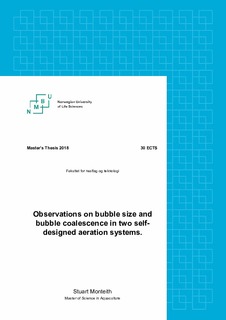| dc.description.abstract | The aeration of water, using either normal air or pure oxygen, is a critical process of Recirculating Aquaculture Systems. Carrying capacity in recirculating systems is typically governed by levels of dissolved oxygen in the water, and in order to allow the metabolic functions of fish to occur unencumbered, additional oxygen must be added. Maximising gas-liquid surface area, by generating small bubbles, will increase the transfer of gases into the water. Reducing bubble coalescence will maintain these smaller bubbles and will enable the effective transfer of gasses into the water with minimal losses in efficiency. In this study, two separately self-designed aeration systems were assembled in order to evaluate bubble size and bubble coalescence, of normal air, as a result of different variables in fresh and saltwater. The first system used a transparent acrylic cylinder (total ø: 150mm, inner ø: 142mm and height: 1m). Webcams were attached to the cylinder at different points to observe bubble diameter and bubble coalescence. Air was injected by a needle, connected to a syringe, which was inserted through the bottom of the cylinder in order to evaluate the effect of water height on bubble diameter. In the next setup, a needle ‘bracelet’, which allowed the distance between two separate needles to be increased from 1cm up to 5cm was used to observe differences in bubble coalescence at these distances. Furthermore, the needle bracelet was also used to alter the angle between two needles, from 0° to 20°, in order to observe the effect of needle angle on bubble coalescence. Rulers attached to the interior of the tank were used for measurements of bubble diameter, whilst bubble coalescence was characterised by observing number of bubbles and bubbles ≥5mm in diameter.
The results showed that initial bubble diameter generated at the bottom of the cylinder was the same in fresh and saltwater. Bubbles near the top of the cylinder were larger in diameter in freshwater than in saltwater. Increasing the distance between the two needles had no overall effect on bubble coalescence. Increasing the angle between the two needles reduced bubble coalescence. Overall, bubble coalescence occurred more frequently in freshwater than in saltwater.
The second system was assembled using transparent PVC pipes (total ø: 32mm & internal ø: 27.2mm) to form a rough ‘U’ shape, with two vertical sections (0.7m in length), and one elongated horizontal section (2m in length). This aeration system used four observation points in order to observe differences in bubble diameter and bubble coalescence at separate sections within the system. A selfdesigned venturi, using a transparent PVC pipe (total ø: 25mm & internal ø: 22mm) with a single needle inserted into the pipe, was installed at the first vertical section of the system. Increasing water velocities; 0.92 m/s, 0.98 m/s, 1.04 m/s, 1.12 m/s, 1.18 m/s, 1.25 m/s and 1.29m/s were generated in order to observe effects on bubble diameter and bubble coalescence at the different observation points.
The results showed that when increasing the water velocity, bubble diameter and bubble coalescence decreased. Bubble diameter was observed to be smallest after the bends in the piping. Whilst bubble diameter was largest at the end of the 2m horizontal pipe, due to increases in bubble coalescence. Overall, both bubble diameter and the frequency of bubble coalescence were smallest in saltwater than in freshwater. | nb_NO |

